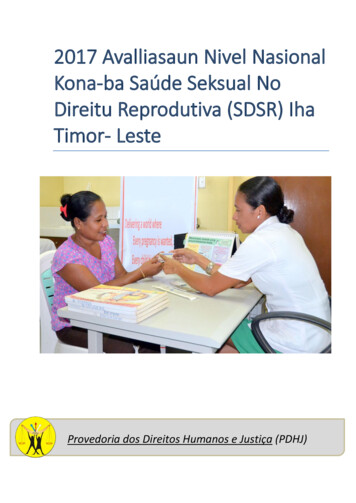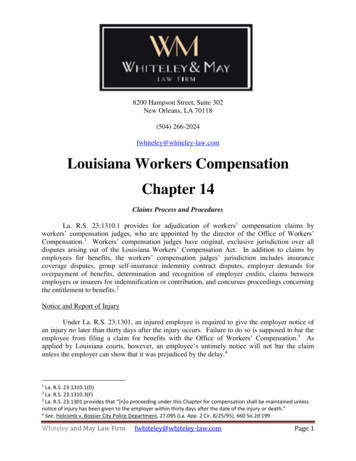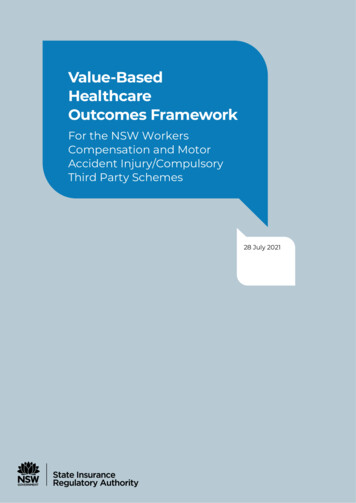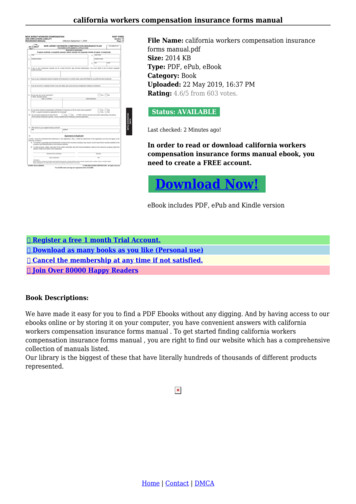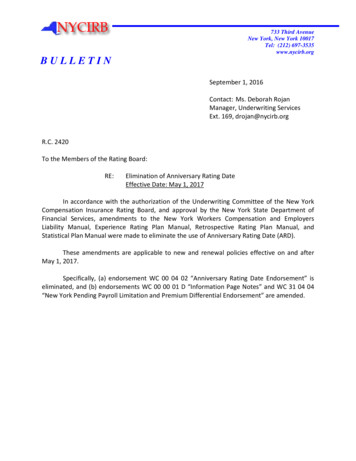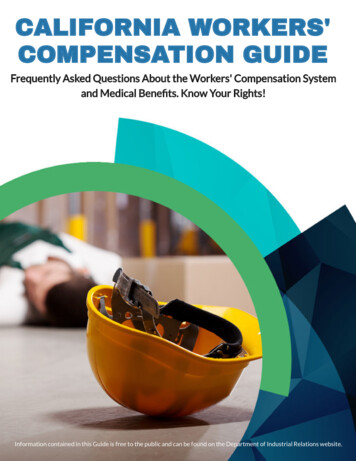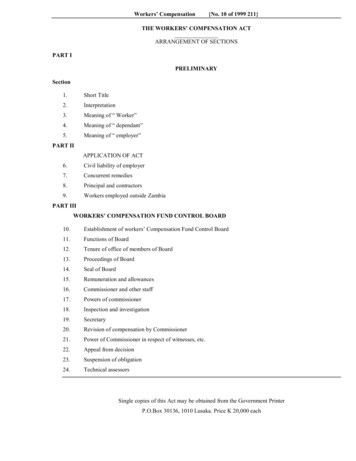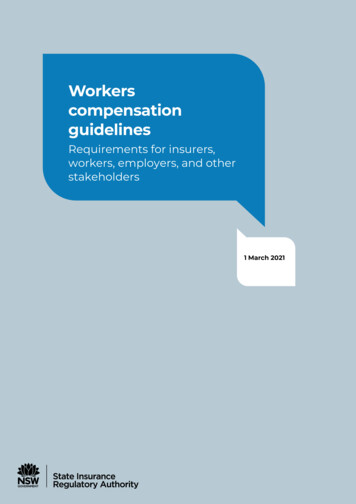
Transcription
WorkerscompensationguidelinesRequirements for insurers,workers, employers, and otherstakeholders1 March 2021
Table of ContentsAbout these Guidelines . 4Context . 4Legislative framework . 4Purpose . 5Guideline-making powers . 5Interpretation . 5Commencement . 5Exempt categories of workers. 5Scope. . 5Part 1: Initial notification of an injury . 71.1Initial notification of injury. 7Part 2: Provisional liability . 82.1Delaying provisional weekly payments .82.2Provisional liability for medical expenses .9Part 3 Making a claim. 103.1Minimum requirements for a claim .103.2Requirement for a claim form .103.3Signed authority .10Part 4: Compensation for medical, hospital, and rehabilitation expenses . 124.1Accessing treatment without pre-approval . 124.2Determining reasonably necessary treatment .144.3Qualifications and requirements for treatment or service providers . 154.4Domestic assistance care plan . 154.5Verifying gratuitous domestic assistance . 164.5.1Verifying and approving gratuitous domestic assistance. 16Part 5: Work capacity Assessment . 175.1Work capacity assessment . 175.2When to conduct a work capacity assessment . 175.3Requirement to attend appointments . 17Part 6: Injury management consultants . 196.1IMC functions relating to the nominated treating doctor . 196.2IMC functions relating to the worker . 196.3IMC functions relating to the employer .206.4IMC functions relating to other service providers .206.5IMC functions relating to the Personal Injury Commission .206.6The IMC report .20Part 7: Independent medical examinations and reports . 227.1Reason for referral . 22State Insurance Regulatory Authority 2
7.2Qualified and appropriate independent medical examiners . 227.2.1Permanent impairment assessors . 237.3Conflict of interest . 237.4Special requirements . 237.5Notification to the worker. 237.6Further independent medical examinations .247.7Unreasonable request . 25Part 8: Lump sum compensation. 268.18.2Relevant particulars about a claim . 268.1.1For injuries received on or after 1 January 2002 . 268.1.2For injuries received before 1 January 2002 . 26Complying agreements . 26Part 9: Commutation of compensation . 279.1Compensation not to be commuted for catastrophic injuries . 279.1.1Spinal cord injury . 279.1.2Brain injury . 279.1.3Amputations . 279.1.4Burns . 289.1.5Permanent blindness . 28Part 10: Pre-injury average weekly earnings . 2910.1Pre-injury average weekly earnings of apprentices, trainees and young people . 2910.2Determining whether a benefit has been provided and whether the worker isentitled to use of the benefit .3010.3 Monetary value of non-monetary benefits.3010.3.1 Residential accommodation not subject to fringe benefits tax . 31State Insurance Regulatory Authority 3
About these GuidelinesThe State Insurance Regulatory Authority (SIRA) is the government organisationresponsible for regulating and administering workers compensation, motor accidentscompulsory third party (CTP) insurance and home building compensation insurance inNew South Wales (NSW).ContextUnder section 23 of the State Insurance and Care Governance Act 2015, a principalobjective of SIRA in exercising its functions is to provide for the effective supervision ofclaims handling and disputes arising under NSW workers compensation legislation.The Workers Compensation Guidelines (Guidelines) are supported by Standards of practice(Standards) which outline claims administration and conduct expectations for insurers.SIRA’s objective in developing the Guidelines and Standards is to improve outcomes in theworkers compensation system by ensuring that clear, consistent, easy to accessexpectations are set for all insurers, to guide insurer conduct and claims management.It is important that injured workers are protected and that they receive appropriate, timely,respectful services and support. Similarly, it is important that employers are activelyengaged in the claims process to support workers with their recovery and return to work.SIRA uses the Guidelines and the Standards to hold insurers accountable for deliveringhigh standards of service to workers and their families, carers, employers and otherstakeholders.Legislative frameworkThe Workers Compensation Act 1987 (1987 Act), the Workplace Injury Management andWorkers Compensation Act 1998 (1998 Act), and the regulations made under those Actsestablish a workplace injury management and workers compensation system in NewSouth Wales.The system objectives as described in section 3 of the 1998 Act are: to assist in securing the health, safety and welfare of workers and, in particular,preventing work-related injury,to provide: prompt treatment of injuries, and effective and proactive management of injuries, and necessary medical and vocational rehabilitation following injuries,in order to assist injured workers and to promote their return to work as soon aspossible, to provide injured workers and their dependants with income support during incapacity,payment for permanent impairment or death, and payment for reasonable treatmentand other related expenses,to be fair, affordable, and financially viable,to ensure contributions by employers are commensurate with the risks faced, takinginto account strategies and performance in injury prevention, injury management, andreturn to work,to deliver the above objectives efficiently and effectively.The Personal Injury Commission Act 2020 (PIC Act) establishes the Personal InjuryCommission of New South Wales on 1 March 2021. The Personal Injury Commission is asingle, independent tribunal and will replace the Workers Compensation Commission andSIRAs Dispute Resolution Services that currently manage disputes involving injuredState Insurance Regulatory Authority 4
workers and road users on and from 1 March 2021. The PIC Act also establishes theIndependent Review Officer (IRO). On and from 1 March 2021, the IRO replaces the WorkersCompensation Independent Review Officer (WIRO) and also assumes functions in themotor accident scheme. The functions of the IRO are set out in Schedule 5 to the PIC Act.PurposeThe Workers Compensation Guidelines (Guidelines) support delivery of the objectives ofthe Acts and Regulation by informing and guiding insurers, workers, employers, injurymanagement consultants, independent medical examiners and other stakeholders in theprocess of claiming workers compensation in NSW.Guideline-making powersThese Guidelines are made under section 376(1)(c) of the 1998 Act, which empowers SIRA toissue guidelines in accordance with specific guideline-making powers throughout theWorkers Compensation Acts. Each Part of these Guidelines identifies the section orsections of the Acts that authorise or require Guidelines to be issued by SIRA.SIRA requires stakeholders to comply with the parts of the Guidelines that apply to them.InterpretationThese Guidelines are to be read in conjunction with relevant provisions of the Acts and theRegulation and in a manner that supports the system objectives as described in section 3of the 1998 Act.CommencementThese Guidelines will take effect and apply to all claims from 1 March 2021 (irrespective ofwhen the claim is made). Part 10 of these Guidelines, pre-injury average weekly earnings,applies only to workers injured on or after 21 October 2019.The Guidelines will apply until SIRA amends, revokes or replaces them in whole or in part.These Guidelines replace the Workers Compensation Guidelines dated 17 April 2020.The Guidelines apply to insurers, workers, employers and other stakeholders as defined inthe 1987 Act and the 1998 Act.The Guidelines do not apply to:a. coal miner matters, as defined in the 1998 Actb. dust disease matters, as defined in the Workers Compensation (Dust Diseases) Act 1942c.claims made under the Workers Compensation (Bush Fire, Emergency and RescueServices) Act 1987.Exempt categories of workersChanges made by the Workers Compensation Legislation Amendment Act 2012 do notapply to police officers, paramedics or firefighters.These workers were exempt from changes because of clause 25 of Part 19H of Schedule 6 tothe 1987 Act. They are known as ‘exempt categories of workers’.Most requirements in these Guidelines apply to exempt categories of workers.Requirements that do not apply are clearly marked.ScopeThe Guidelines contain the following parts: Part 1: Initial notification of an injury Part 2: Provisional liabilityState Insurance Regulatory Authority 5
Part 3: Making a claim Part 4: Compensation for medical, hospital, and rehabilitation expenses Part 5: Work capacity Part 6: Injury management consultants Part 7: Independent medical examinations and reports Part 8: Lump sum compensation Part 9: Commutation of compensation Part 10: Pre-injury average weekly earningsWords defined in the NSW workers compensation legislation have the same meaning inthese Guidelines.State Insurance Regulatory Authority 6
Part 1: Initial notification of an injury1.1Initial notification of injurySection 266 of the 1998 Act provides that initial notification to an insurer of an injury to aworker means the first notification of the injury that is given to the insurer, in the mannerand form required by the Workers Compensation Guidelines, by the worker or theemployer or by some other person (for example, a medical practitioner) acting for or onbehalf of the worker or the employer.Notifications can be written (including online or by email) or verbal (including by phone).Table 1.1Required information for the initial notification of injuryThe following information is required to be provided to the insurer in order for there to bean initial notification:CategoryRequired informationWorker NameContact details (including a phone number and postal address)Employer Business nameBusiness contact detailsTreating doctor(where known) NameName of medical centre or hospital (if known)Injury Date of the injury or the period over which the injury emergedTime of the injuryDescription of how the injury happenedDescription of the injuryWhether any medical treatment is requiredWhether the injury has caused any partial or total incapacity forwork and loss of incomeNotifier NameRelationship to the worker or employerContact details (including phone number and postal address)If the insurer receives an incomplete initial notification of injury, it must inform thenotifier (and the worker, where possible) within three business days and specify whatadditional information is needed.State Insurance Regulatory Authority 7
Part 2: Provisional liability2.1Delaying provisional weekly paymentsOnce the insurer has received an initial notification of injury it must: start provisional payments within seven calendar days unless there is a reasonableexcuse not to or delay starting provisional weekly payments by issuing a reasonable excuse withinseven days or determine liability.Section 267(2) of the 1998 Act allows the Guidelines to define what a ‘reasonable excuse’may be.Table 2.1Reasonable excuses for not starting provisional weeklypaymentsThe insurer has a reasonable excuse for not starting provisional weekly payments if any ofthe following apply:ExcuseReasonThere is insufficientmedical informationThe insurer does not have enough medical information toestablish that there is an injury, as a workers compensationcertificate of capacity (or other medical information certifyingthat a work-related injury has occurred) has not been provided.If a certificate of capacity or other medical information isprovided and includes a clear diagnosis, the claim cannot bereasonably excused using this reason.Note: Insurers are to use discretion for workers in remote areasif access to medical treatment is not readily available.The injured person isunlikely to be a workerThe person cannot verify they are a worker.orThe employer can verify that they are not a worker.If there is any doubt that someone is a worker under NSWworkers compensation law, the insurer must verify thatperson’s status.Information that confirms this may include, but is not limitedto: The insurer is unableto contact the workerthe employer agreeing to the worker’s statusthe worker’s payroll numbera current payslip or a bank statement with regular employerpaymentsa contract of employment or services.The insurer has not been able to contact the worker after atleast: two attempts by phone (made at least a day apart) andone attempt in writing (which may include an attempt byemail).State Insurance Regulatory Authority 8
The worker refusesaccess to informationThe worker will not agree to the release or collection ofpersonal or health information relevant to the injury sufficientto determine provisional liability.The injury is not workrelatedThe insurer has information that: the worker did not receive an injury which is compensableunder the NSW workers compensation law, orstrongly indicates that compensation for an injury may notbe payable under NSW workers compensation law.If the employer believes the injury is not work-related, they areto provide the insurer with any supporting evidence they have,such as: medical information that the condition already existed andhas not been aggravated by workfactual information that the injury did not arise from orduring employment.Note: Suspicion, innuendo, anecdotes or unsupportedinformation from any source, including the employer, is notacceptable.There is norequirement forweekly paymentsBased on the information received as part of the notification ofinjury or otherwise obtained by the insurer, the insurer isreasonably satisfied there is no requirement for weeklypayments, for example because the injury has not resulted inany incapacity or loss of earnings.The injury is notifiedafter two monthsThe notice of injury is not given to the employer within twomonths of the date of injury.Note: This reason cannot be used if the acceptance of liability islikely and provisional payments will be an effective way tomanage the injury.A reasonable excuse may apply to provisional weekly payments but not to provisionalmedical payments.Where applicable, prior to deciding not to commence provisional weekly payments on thebasis of a reasonable excuse, the insurer is to attempt to resolve the reasonable excuse.2.2Provisional liability for medical expensesSection 280 of the 1998 Act allows the Guidelines to specify the amount up to which aninsurer can provisionally accept liability for medical expenses relating to a work-relatedinjury.An insurer can accept liability for medical expenses on a provisional basis and pay up to 10,000 before being required to make a formal determination of liability.State Insurance Regulatory Authority 9
Part 3 Making a claimIn making a claim, workers are asserting a right to receive workers compensation benefitsbecause they believe they meet the necessary legal requirements.Section 260(2) of the 1998 Act allows the Guidelines to make provision for or withrespect to certain matters in connection with the making of a claim, including: the form and manner in which a claim is to be made the means by which a claim may be made the information that a claim is to contain requiring specified documents and other material to be included with a claim.3.1 Minimum requirements for a claimAs a minimum, a claim for compensation must provide the insurer with the followinginformation: name and contact details of the worker name and contact details of the employer (individual or organisation) name and contact details of the worker’s medical practitioner if applicable, the name and contact details of any witnesses or witness statements,including details to identify any witnesses known to the worker if the incident waswitnessed. description of the injury and how it happened information to support the medical expenses and other losses the worker is claiming.3.2 Requirement for a claim formWorkers are able to complete and submit a claim form to an insurer at any time, subject tothe time limits outlined in the 1998 Act. Claim forms are available from the SIRA website orinsurers may have their own claim form.An insurer must require a worker to complete a claim form when: a reasonable excuse notice has been issued, the worker is seeking weekly payments ofcompensation and the reasonable excuse is still relevant, or compensation is likely to be claimed beyond the provisional liability limits and theinsurer determines that there is insufficient information to determine ongoing liability.The insurer can waive the requirement for a worker to submit a claim form if theydetermine they have enough information to make a liability determination.3.3Signed authoritySection 260(3) of the 1998 Act allows the Guidelines to require that a claim be accompaniedby a form of authority signed by the worker. This signed authority authorises the sharing ofinformation between service providers and the insurer.The worker may be required to supply the insurer with a signed authority so providers ofmedical and hospital treatment or workplace rehabilitation services can give the insurerrelevant information relating to the compensable injury.Information relevant to the worker’s injury includes: the treatment or service provided, or the worker’s medical condition, orState Insurance Regulatory Authority 10
treatment relevant to the claim.This authority forms part of the claim form available on the SIRA website. Alternatively, theinsurer can use its own form.State Insurance Regulatory Authority 11
Part 4: Compensation for medical, hospital, andrehabilitation expenses4.1Accessing treatment without pre-approvalDoes not apply to exempt workersThere is no requirement for exempt workers to seek pre-approval for treatment.However, exempt workers are to be made aware that treatment and services may not bepayable without insurer approval.Payment of treatment and services for exempt workers must be assessed based onwhether the treatment or service is required as a result of the injury and is consideredreasonably necessary and on the provision of properly verified costs.Workers can claim expenses relating to medical treatments and services, including hospitaland rehabilitation.Medical, hospital and rehabilitation expenses will be paid where the treatment or service: meets the definitions described in section 59 of the 1987 Act takes place while the worker is entitled to receive compensation (the compensationperiod) for medical, hospital and rehabilitation expenses is reasonably necessary because of the injury is pre-approved by the insurer (unless the treatment or service is exempt from preapproval – see below).Section 60(2A) of the 1987 Act allows the Guidelines to specify the types or classes oftreatment or services that are exempt from the requirement for prior insurer approval.See Table 4.1 for the reasonably necessary treatments and services the worker can receive(including reasonably necessary worker travel), without pre-approval from the insurer.Table 4.1 Reasonably necessary treatments and services available withoutpre-approval from the insurerTreatmentExpenseTimeframe fromdate of injuryInitial treatmentInitial treatmentWithin 48 hoursNominated treatingdoctorConsultation or case-conferencing for theinjury, apart from home visitsOngoingTreatment during consultationWithin onemonthServices provided in the emergencydepartment for the injuryOngoingFurther services after receiving treatment atthe emergency department for the injuryWithin onemonthIf referred by the nominated treating doctor,any consultation and treatment duringconsultations for the injury. Referrals fordiagnostic tests must meet the MedicareBenefits Schedule criteria.Within threemonthsPublic hospitalMedical specialistsNote: Medical specialist means a medicalpractitioner recognised as a specialist by theAustralian Health Practitioner RegulationState Insurance Regulatory Authority 12
Agency and remunerated at specialist ratesunder Medicare.DiagnosticinvestigationsIf referred by the nominated treating doctorfor the injury: Within two weeksany plain x-raysIf referred by the nominated treating doctor,and the worker has been referred to amedical specialist for further injurymanagement: ultrasounds and CT scans MRIsWithin threemonthsNote: General Practitioners must satisfy theMedicare Benefits Schedule criteria whenmaking a referral for an MRI.PharmacyIf referred by the treating medical specialistfor the injury, any diagnostic investigationsWithin threemonthsDispensed prescription drugs and over-thecounter pharmacy items prescribed for theinjury by the nominated treating doctor ormedical specialistWithin onemonthPrescription drugs and over-the-counterpharmacy items prescribed for the injuryand dispensed through the PharmaceuticalBenefits Scheme (PBS)OngoingTable 4.2 Other treatments and services available without pre-approvalfrom the insurerTreatmentExpenseSIRA-approved alliedhealth practitionersUp to eight consultations if the injury was not previously treatedby a provider from the same allied health practitioner group(either 1. Physical or 2. Psychological) and the treatment beginswithin three months of the sts)2. Psychologicalpractitioners(psychologistsand counsellors)Up to eight consultations per Allied health recovery request(AHRR) if the same practitioner is continuing treatment withinthree months of the injury and: the practitioner sent an AHRR to the insurer, andthe insurer did not respond within five working days ofreceiving the AHRR.Up to three consultations if the injury was not previously treatedby a provider from the same allied health practitioner group(either 1. Physical or 2. Psychological) and the treatment beginsmore than three months after the injury.One consultation with the same practitioner if the practitionerpreviously treated the injury more than three months ago. This isconsidered a new episode of care.State Insurance Regulatory Authority 13
One consultation with a different practitioner if the injury waspreviously treated by a provider from the same allied healthpractitioner group (either 1. Physical or 2. Psychological).Up to two hours per practitioner for case conferencing thatcomplies with the applicable Fees Order.Up to 110 per claim for reasonable incidental expenses for itemsthe worker uses independently at their home or workplace (suchas strapping tape, theraband, exercise putty, disposableelectrodes and walking sticks).Interim paymentdirectionAny treatment or service under an interim payment directionfrom the President (or delegate)of the Personal InjuryCommission as outlined in section 297 of the 1998 Act.CommissiondeterminationAny disputed treatment or service the Personal InjuryCommission has determined must be paid.Permanentimpairm
The Guidelines will apply until SIRA amends, revokes or replaces them in whole or in part. These Guidelines replace the Workers Compensation Guidelines dated 17 April 2020. The Guidelines apply to insurers, workers, employers and other stakeholders as defined in the 1987 Act and the 1998 Act. The Guidelines do not apply to:
